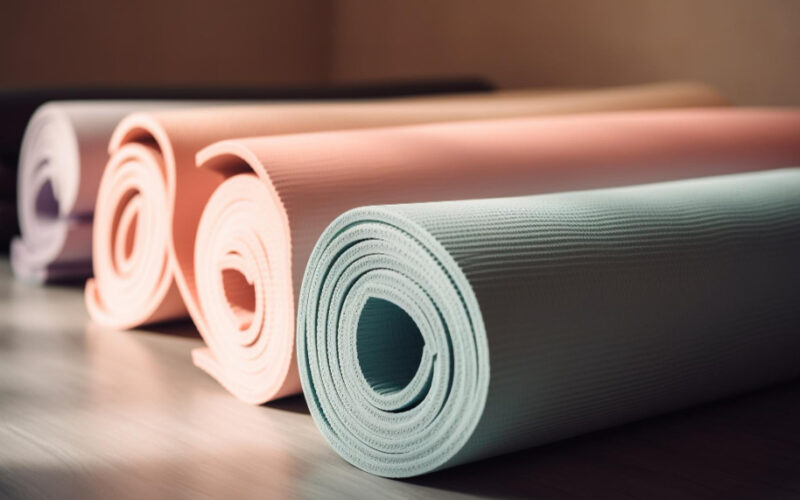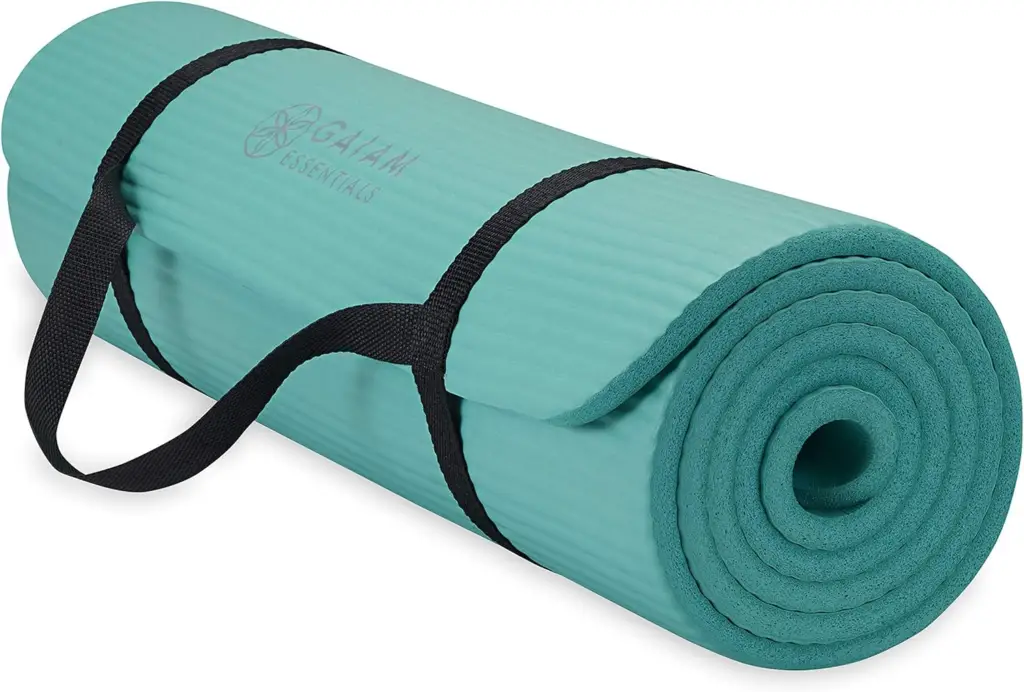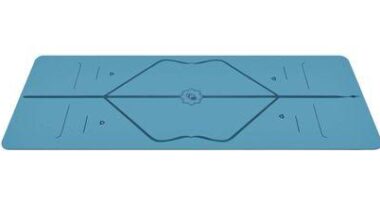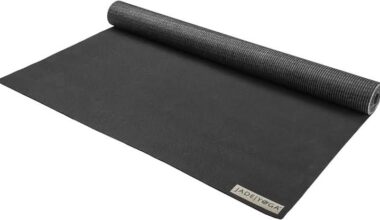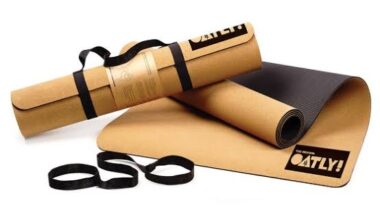Table of Contents Show
Struggling to choose between a TPE and PU yoga mat? Discover the key differences, benefits, and drawbacks of each material to make the best choice for your yoga practice.
When it comes to the ultimate yoga experience, the age-old debate between “TPE vs PU Yoga Mat” is always a hot topic. With so many options on the market, it’s crucial to know the differences between these two popular materials to make an informed decision. In this comprehensive guide, we’ll dive deep into the world of TPE and PU yoga mats, comparing their grip, comfort, eco-friendliness, durability, maintenance, and price.
Disclosure: As an Amazon Associate I earn from qualifying purchases.
So, let’s unroll the facts and find the perfect yoga mat for you!
TPE vs PU Yoga Mat: Which One Is Right for You?
Yoga has experienced a surge in popularity, with more people looking for the perfect yoga mat to enhance their practice. There’s a wide variety of materials available, but TPE (Thermoplastic Elastomer) and PU (Polyurethane) yoga mats have emerged as popular choices. Hence the need to explore the differences between TPE and PU yoga mats to help you make an informed decision that aligns with your personal preferences and practice style.
Thermoplastic Elastomer (TPE) Yoga Mats
Thermoplastic Elastomer, or TPE, is a modern material that has gained popularity for its unique blend of plastic and rubber-like properties. TPE yoga mats are known for their lightweight nature, flexibility, and soft texture. But is TPE the right choice for your next yoga mat? Let’s explore the properties of TPE yoga mats in more detail.
Polyurethane (PU) Yoga Mats
Polyurethane, or PU, is a versatile and high-performance material often used in various applications, from footwear to insulation. PU yoga mats are celebrated for their excellent grip, durability, and sweat-absorbing properties. But how do they stack up against TPE yoga mats? Keep reading to find out.
TPE vs PU Yoga Mat: A Deep Comparison
Grip and Traction
Grip is essential when practising yoga, especially during those sweaty hot yoga sessions. Slipping and sliding on your mat is not only frustrating but can also lead to injuries. So, how do TPE and PU yoga mats compare when it comes to grip and traction?
TPE Yoga Mats Grip Performance:
- TPE mats offer a decent grip for most yoga practices
- Grip can be compromised when exposed to excessive moisture or sweat
PU Yoga Mats Grip Performance:
- PU mats provide exceptional grip, even in sweaty conditions
- Grip increases as the mat gets wetter, making it perfect for hot yoga and intense workouts
Comparison of Grip Between TPE and PU:
- PU yoga mats outperform TPE mats in terms of grip, especially in hot or sweaty conditions
- TPE mats may be suitable for less intense yoga practices, where grip is less critical
Comfort and Cushioning
When practising yoga, the last thing you want is an uncomfortable mat that causes aches and pains. A good yoga mat should provide ample cushioning to protect your joints and keep you comfortable during your practice. So, how do TPE and PU yoga mats measure up in terms of comfort and cushioning?
TPE Yoga Mats Cushioning Properties:
- TPE mats are known for their soft, plush texture, providing excellent cushioning for your joints
- These mats tend to be thicker than PU mats, offering more padding and support
PU Yoga Mats Cushioning Properties:
- PU mats are often thinner than TPE mats, which can lead to a firmer feel
- However, many PU mats feature a rubber or foam base for added cushioning and support
Comparison of Cushioning Between TPE and PU:
- TPE yoga mats generally provide more cushioning due to their thicker and softer material
- PU yoga mats can still offer adequate padding with the help of a supportive base layer
Eco-friendliness and Sustainability
With growing concerns about our planet’s health, many people are looking for eco-friendly options in all aspects of their lives
, including their yoga mats. So, which material is more environmentally friendly: TPE or PU?
TPE Yoga Mats’ Environmental Impact:
- TPE is considered more eco-friendly than traditional PVC materials
- TPE is recyclable and can be reprocessed multiple times
- However, some TPEs may contain small amounts of harmful substances, such as heavy metals or phthalates
PU Yoga Mats’ Environmental Impact:
- PU is not as eco-friendly as TPE or other natural materials like cork or rubber
- PU mats can take longer to decompose in landfills compared to TPE mats
- PU production process may involve the use of toxic chemicals
Comparison of Eco-friendliness Between TPE and PU:
- TPE yoga mats are generally more eco-friendly than PU yoga mats
- However, both materials have some environmental drawbacks, and neither is the perfect “green” option
- If eco-friendliness is a top priority, consider exploring natural materials like cork or rubber
Durability and Lifespan
A yoga mat is an investment, so it’s essential to choose one that will stand the test of time. How do TPE and PU yoga mats compare when it comes to durability and lifespan?
TPE Yoga Mats’ Durability:
- TPE mats can be prone to wear and tear over time, especially with heavy use
- Some users may experience issues with flaking or peeling after extended use
PU Yoga Mats’ Durability:
- PU mats are known for their durability and resistance to wear and tear
- With proper care, PU mats can last for several years, even with regular use
Comparison of Durability Between TPE and PU:
- PU yoga mats are generally more durable than TPE mats
- If longevity is a top priority, a PU yoga mat may be a better investment
Maintenance and Care
No matter how much you love your yoga mat, it will inevitably need cleaning and maintenance to keep it fresh and functional. How do TPE and PU yoga mats compare when it comes to maintenance and care?
Cleaning and Maintaining TPE Yoga Mats:
- TPE mats are easy to clean with a simple wipe-down using a damp cloth and mild soap
- It’s essential to avoid using harsh chemicals, as they can break down the TPE material
- TPE mats should be air-dried and kept out of direct sunlight to prevent damage
Cleaning and Maintaining PU Yoga Mats:
- PU mats can be cleaned with a damp cloth and mild soap, just like TPE mats
- Some PU mats may require occasional deep cleaning with a gentle cleanser to remove stubborn stains or odours
- PU mats should also be air-dried and kept out of direct sunlight
Comparison of Maintenance Between TPE and PU:
- Both TPE and PU yoga mats are relatively easy to maintain and clean
- Maintenance requirements are generally similar for both materials, with minor differences in cleaning frequency or method
Price and Affordability
When choosing a yoga mat, price and affordability are often significant factors. How do TPE and PU yoga mats compare when it comes to cost?
TPE Yoga Mats’ Price Range:
- TPE mats are generally more affordable than PU mats
- Prices can vary depending on the brand and quality, but TPE mats are generally accessible to most budgets
PU Yoga Mats’ Price Range:
- PU mats tend to be more expensive than TPE mats
- The higher cost is often justified by the mat’s superior grip, durability, and overall performance
Comparison of Price Between TPE and PU:
- TPE yoga mats are generally more budget-friendly than PU yoga mats
- If you’re willing to invest in a higher-priced mat, PU mats may offer better performance and durability
- Both materials have options across various price ranges, so it’s essential to find one that meets your needs and budget
Pros and Cons of TPE and PU Yoga Mats
Advantages of TPE Yoga Mats
- Lightweight and portable
- Soft and comfortable cushioning
- Generally more affordable
- More eco-friendly than traditional PVC materials
- Easy to clean and maintain
Disadvantages of TPE Yoga Mats
- Grip can be compromised in sweaty conditions
- Less durable compared to PU mats
- May contain small amounts of harmful substances
Advantages of PU Yoga Mats
- Superior grip, even in sweaty conditions
- Highly durable and long-lasting
- Easy to clean and maintain
- Excellent performance for hot yoga and intense workouts
Disadvantages of PU Yoga Mats
- Generally more expensive than TPE mats
- Less eco-friendly compared to TPE and other natural materials
- May require occasional deep cleaning for stubborn stains or odours
How to Choose the Right Yoga Mat for You
Assessing Your Priorities
When deciding between a TPE and PU yoga mat, consider factors such as grip, comfort, eco-friendliness, durability, maintenance, and price. What aspects are most important to you? Are you willing to compromise on certain features for a more budget-friendly option?
Considering Your Yoga Practice
Think about the type of yoga you practice and how a TPE or PU yoga mat might suit your needs. Do you need a mat with exceptional grip for hot yoga? Or are you more focused on comfort and cushioning for gentle, restorative practices?
Trying Before Buying
Nothing beats the experience of testing a yoga mat in person. Many yoga studios or retailers offer try-before-you-buy options, allowing you to feel the mat’s texture, grip, and cushioning before making a purchase. Don’t be afraid to test out different TPE and PU yoga mats to find the one that feels just right.
Conclusion
The “TPE vs PU Yoga Mat” debate ultimately comes down to personal preferences and priorities. TPE mats are lightweight, comfortable, and more affordable, making them an excellent option for casual yoga practitioners or those on a budget. On the other hand, PU yoga mats offer superior grip, durability, and performance, making them a worthwhile investment for avid yogis or those who frequently practice hot yoga.
By carefully considering your needs, priorities, and budget, you’ll be well on your way to finding the perfect yoga mat that will support and enhance your practice for years to come.
You May Also Like: Vinyasa Yoga vs Power Yoga: 7 Eye-Opening Differences
FAQs
Q1: Are TPE or PU yoga mats better for hot yoga?
A1: PU yoga mats are generally better for hot yoga due to their superior grip, even in sweaty conditions. As the mat gets wetter, the grip increases, making it an ideal choice for hot yoga or intense workouts.
Q2: Can I use a TPE yoga mat if I have latex allergies?
A2: Yes, TPE yoga mats are typically latex-free and hypoallergenic, making them suitable for those with latex allergies. However, it’s always a good idea to double-check with the manufacturer to ensure the specific mat you’re considering is latex-free.
Q3: How often should I clean my TPE or PU yoga mat?
A3: Both TPE and PU yoga mats should be cleaned regularly to maintain hygiene and performance. Wipe down your mat with a damp cloth and mild soap after each use, or at least once a week if you practice less frequently. For PU mats, occasional deep cleaning with a gentle cleanser might be necessary to remove stubborn stains or odours.
Q4: How long do TPE and PU yoga mats last?
A4: The lifespan of a yoga mat depends on its material, quality, and how well it’s maintained. TPE mats may wear down more quickly, with some users experiencing issues after a year or two of heavy use. In contrast, PU mats are known for their durability and can last for several years with proper care.
Q5: Are there any eco-friendly alternatives to TPE and PU yoga mats?
A5: Yes, if you’re looking for more environmentally friendly options, consider natural materials like cork or rubber. Cork mats are sustainable, biodegradable, and provide excellent grip, while rubber mats offer excellent cushioning and are made from renewable resources.
Q6: Can I use a towel or rug instead of a TPE or PU yoga mat?
A6: While you can practice yoga on a towel or rug, it may not provide the same level of grip, cushioning, and support as a dedicated yoga mat. If you’re serious about your yoga practice, investing in a TPE or PU mat can significantly improve your experience and help prevent injuries.
Q7: How do I know when it’s time to replace my TPE or PU yoga mat?
A7: It’s time to replace your yoga mat when it no longer provides the grip, support, and cushioning you need for a comfortable and safe practice. Signs that it’s time for a new mat include visible wear and tear, peeling or flaking, or diminished grip.
Q8: How can I increase the grip on my TPE yoga mat?
A8: To improve the grip on your TPE yoga mat, try using a yoga towel or rosin powder. A yoga towel can be placed on top of your mat to absorb sweat and increase traction, while rosin powder can be dusted on your hands and feet to reduce slipping.
Q9: What’s the best way to store my TPE or PU yoga mat?
A9: To prolong the life of your yoga mat, store it rolled up and out of direct sunlight, as prolonged exposure can cause damage to the material. Avoid folding your mat, as this can create creases and weaken the material over time.
Q10: Are there any accessories that can enhance my experience with a TPE or PU yoga mat?
A10: Yes, there are several accessories that can improve your yoga experience with a TPE or PU mat. Some popular options include yoga straps for carrying your mat, yoga blocks for added support and alignment, and yoga towels to enhance grip and absorb sweat during intense practices.
Q11: What does TPE stand for?
A11: TPE stands for “Thermoplastic Elastomer” It is a type of material that combines the characteristics of thermoplastics and elastomers. Thermoplastics are materials that can be melted and re-moulded multiple times without losing their properties, while elastomers are materials with a rubber-like elasticity. TPEs offer a balance of flexibility, durability, and processability, making them suitable for a wide range of applications, including automotive parts, consumer products, medical devices, and more.
Q12: Is TPE Yoga Mat Safe?
A12: Yes, TPE (Thermoplastic Elastomer) yoga mats are generally considered safe. TPE is free from harmful chemicals like PVC, latex, and phthalates. However, it’s essential to check individual product specifications and follow care instructions for optimal safety.
